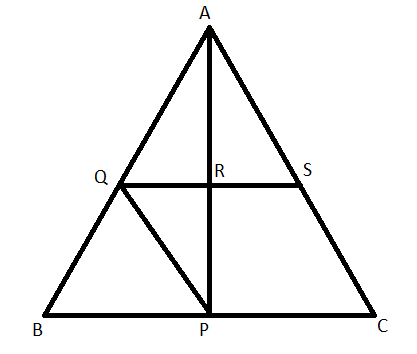
In triangle ABC, P is the midpoint of side BC. A line through p and parallel to CA meets AB at point Q; and a line through Q meets at S. QS parallel to BC meets median AP at point R. Prove that:
(I) AP = 2AR
(II) BC = 4QR
Answer
602.4k+ views
Hint: For solving this problem, the knowledge of the midpoint theorem in a triangle is necessary. By drawing the figure, we can easily apply the midpoint theorem in suitable triangles to obtain the desired result.
Complete step-by-step answer:

Given: In triangle ABC, P is the midpoint of BC. Also, PQ is parallel to CA and meets AB at point Q. QS is parallel to BC and meets AP at point R.
To prove: AP = 2AR and BC = 4QR.
Proof:
The midpoint theorem states that “The line segment in a triangle joining the midpoint of two sides of the triangle is said to be parallel to its third side and is also half of the length of the third side.”
In triangle ABC, P is the midpoint of BC and PQ is parallel to AB. Now, by using the converse of the midpoint theorem, Q is the midpoint of AB.
In triangle ABP, Q is the midpoint of AB and QR is parallel to BP. Again, by using the converse of the midpoint theorem, R is the midpoint of AP.
So, we concluded that AP = 2AR.
For, proving the part (ii), consider triangle ABP which is having Q as the midpoint of AB and R as the midpoint of AP. Now, by using the midpoint theorem:
$QR=\dfrac{1}{2}BP$
Replacing BP as half of BC as P is the midpoint of BC, we get
$\begin{align}
& QR=\dfrac{1}{2}\left( \dfrac{1}{2}BC \right) \\
& QR=\dfrac{1}{4}BC \\
& \therefore BC=4QR \\
\end{align}$
So, we proved both the parts individually.
Note: The key concept involved in solving the problem is the knowledge of midpoint theorem. By using the result obtained as a consequence of the midpoint theorem, we easily proved required statements. This knowledge is very helpful in solving complex problems.
Complete step-by-step answer:

Given: In triangle ABC, P is the midpoint of BC. Also, PQ is parallel to CA and meets AB at point Q. QS is parallel to BC and meets AP at point R.
To prove: AP = 2AR and BC = 4QR.
Proof:
The midpoint theorem states that “The line segment in a triangle joining the midpoint of two sides of the triangle is said to be parallel to its third side and is also half of the length of the third side.”
In triangle ABC, P is the midpoint of BC and PQ is parallel to AB. Now, by using the converse of the midpoint theorem, Q is the midpoint of AB.
In triangle ABP, Q is the midpoint of AB and QR is parallel to BP. Again, by using the converse of the midpoint theorem, R is the midpoint of AP.
So, we concluded that AP = 2AR.
For, proving the part (ii), consider triangle ABP which is having Q as the midpoint of AB and R as the midpoint of AP. Now, by using the midpoint theorem:
$QR=\dfrac{1}{2}BP$
Replacing BP as half of BC as P is the midpoint of BC, we get
$\begin{align}
& QR=\dfrac{1}{2}\left( \dfrac{1}{2}BC \right) \\
& QR=\dfrac{1}{4}BC \\
& \therefore BC=4QR \\
\end{align}$
So, we proved both the parts individually.
Note: The key concept involved in solving the problem is the knowledge of midpoint theorem. By using the result obtained as a consequence of the midpoint theorem, we easily proved required statements. This knowledge is very helpful in solving complex problems.
Recently Updated Pages
Master Class 10 General Knowledge: Engaging Questions & Answers for Success

Master Class 10 Computer Science: Engaging Questions & Answers for Success

Master Class 10 English: Engaging Questions & Answers for Success

Master Class 10 Social Science: Engaging Questions & Answers for Success

Master Class 10 Maths: Engaging Questions & Answers for Success

Master Class 10 Science: Engaging Questions & Answers for Success

Trending doubts
The shortest day of the year in India

Why is there a time difference of about 5 hours between class 10 social science CBSE

Write a letter to the principal requesting him to grant class 10 english CBSE

What is the median of the first 10 natural numbers class 10 maths CBSE

The Equation xxx + 2 is Satisfied when x is Equal to Class 10 Maths

State and prove converse of BPT Basic Proportionality class 10 maths CBSE




